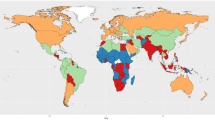Abstract
Comparing children’s wellbeing across countries has been a growing interest over the last two decades. The ranking method is frequently used to compare nations in a league table. While this provides an easy means of comparison, it may also conceal other, more specific information. As a complement to the ranking method, the cluster analysis approach classifies countries into groups by distinguishing their similarities and differences based on the dimensions which define children’s wellbeing. Extending beyond ranking to clustering, this alternative approach may enhance a broader understanding of comparative child wellbeing and facilitate more possibilities for future research. Based on the data in the latest report on children’s wellbeing published by United Nations Children’s Fund (UNICEF) in 2013, this study demonstrates the use of clustering approach as a complement to the ranking method in comparing the wellbeing of children across countries.



Similar content being viewed by others
References
Aldenderfer, M. S., & Blashfield, R. K. (1984). Cluster analysis. Beverly Hills, CA: Russell Sage Publications.
Bauer, R. A. (Ed.). (1966). Social indicators. Cambridge: MIT Press.
Ben-Arieh, A. (1999). The international effort to measure and monitor the state of children: A summary and agenda for future. In A. B. Andrews & N. K. Kaufman (Eds.), Implementing the U.N. convention on the rights of the child: A standard of living adequate for development (pp. 33–46). Westport: Praeger.
Ben-Arieh, A. (2008). The child indicators movement: past, present, and future. Child Indicators Research, 1, 3–16.
Ben-Arieh, A., & Goerge, R. (2001). Beyond the numbers: how do we monitor the state of our children? Children and Youth Services Review, 23(8), 603–631.
Ben-Arieh, A., & Wintersberger, H. (1997). Monitoring and measuring the state of children: Beyond survival. Eurosocial Report No. 62. Vienna: European Centre for Social Welfare Policy and Research.
Ben-Arieh, A., Kaufman, H. N., Andrews, B. A., Goerge, R., Lee, B. J., & Aber, J. L. (2001). Measuring and monitoring children’s well-being. Dordrecht: Kluwer Academic Publishers.
Blashfield, R. K., & Aldenderfer, M. S. (1988). The methods and problems of cluster analysis. In J. R. Nesselroade & R. B. Cattell (Eds.), Handbook of multivariate experimental psychology (pp. 447–473). New York: Plenum Press.
Bradshaw, J., Hoelscher, P., & Richardson, D. (2007). An index of child well-being in the European Union. Social Indicators Research, 80, 133–177.
Bradshaw, J., Martorano, B., Natali, L., & de Neubourg, C. (2013). Children’s subjective well-being in rich countries. Child Indicators Research. doi:10.1007/s 12187-013-9196-4. Advance online publication.
Dijkstra, T. (2009). Child well-being in rich countries: UNICEF’s ranking revisited, and new symmetric aggregating operators exemplified. Child Indicators Research, 2(3), 303–317.
Everitt, B. S. (2009). Multivariable modelling and multivariate analysis for the behavioral sciences. Boca Raton: CRC Press.
Hair, J. F., Black, B., Babin, B., Anderson, R. E., & Tatham, R. L. (1998). Multivariate data analysis. Upper Saddle River: Pearson Prentice Hall.
Heshmati, A., Tausch, A., & Bajalan, C. (2008). Measurement and analysis of child well-being in middle and high income countries. The European Journal of Comparative Economics, 5(2), 187–249.
Klocke, A., Clair, A., & Bradshaw, J. (2013). International variation in child subjective well-being. Child Indicators Research. doi:10.1007/s12187-013-9196-4. Advance online publication.
Martorano, B., Natali, L., de Neubourg, C., & Bradshaw, J. (2013a). Child well-being in advanced economies in the late 2000s. Social Indicators Research. doi:10.1007/s11205-013-0402-z. Advance online publication.
Martorano, B., Natali, L., de Neubourg, C., & Bradshaw, J. (2013b). Child well-being in economically rich countries: Changes in the first decade of the 21st century. Working paper 2013-02. Florence: UNICEF Office of Research.
OECD. (2009). Doing better for children. Paris: Author.
OECD. (2012a). OECD family database. Paris: Author.
OECD. (2012b). OECD social expenditure database. Paris: Author.
OECD. (2012c). OECD education database. Paris: Author.
Phipps, S. (2006). Using indicators of child well-being at the international level. In A. Ben-Arieh & R. M. Goerge (Eds.), Indicators of children’s well-being: Understanding their role, usage and policy influence (pp. 83–90). Dordrecht: Springer.
Qvortrup, J. (1999). The meaning of child’s standard of living. In A. B. Andrews & N. H. Kaufman (Eds.), Implementing the U.N. convention on the rights of the child: A standard of living adequate for development (pp. 47–58). Westport: Praeger.
Richardson, D., Hoelscher, O., & Bradshaw, J. (2008). Child well-being in Central and Eastern European Countries (CEE) and the Commonwealth of Independent States (CIS). Child Indicators Research, 1, 211–250.
UNICEF. (2007). Child poverty in perspective: An overview of child well-being in rich countries. Innocenti report card 7. Florence: UNICEF Innocenti Research Centre.
UNICEF Office of Research. (2013). Child well-being in rich countries: A comparative overview. Innocenti report card 11. Florence: UNICEF Office of Research.
Author information
Authors and Affiliations
Corresponding author
Rights and permissions
About this article
Cite this article
Cho, E.YN. A Clustering Approach to Comparing Children’s Wellbeing Across Countries. Child Ind Res 7, 553–567 (2014). https://doi.org/10.1007/s12187-013-9229-z
Accepted:
Published:
Issue Date:
DOI: https://doi.org/10.1007/s12187-013-9229-z




